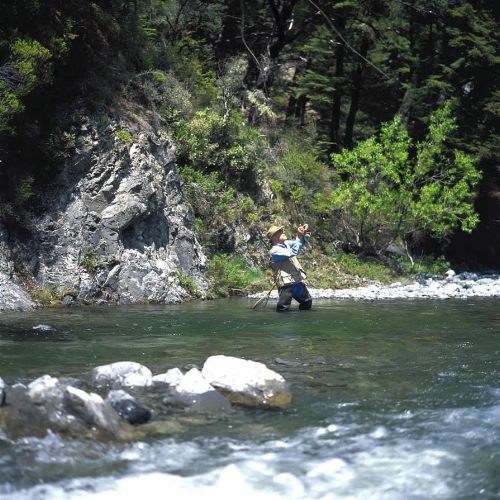Myths and Legends of the Marlborough Sounds
/Tutanekai is an old fella now. He’s 74 years old, strong and sturdy, and he knows the waterways of Queen Charlotte Sound like the back of his hand. Nothing unusual you might think, except Tutanekai is a boat. “A very masculine boat,” according to his owners.
Leaving from Waikawa Bay near Picton early that morning Tutanekai was eager to set out. With Peter at the helm and Tukatai running round tidying up and getting people comfortable the weekend held great promise. The plan was a day cruising Queen Charlotte Sound, following the stories and legends of the area as they unfolded. We would stay the night on the far tip of Arapawa Island, then spend tomorrow exploring that remote corner of the Marlborough Sounds before cruising back to Picton later in the day.
Peter grew up in the Marlborough Sounds and has rarely left the area; his local knowledge is impressive. Tukatai is Maori, with a deep affinity to the land and sea handed down through generations of tangata whenua, her people of the land. They both hold kaitiakitanga, or guardianship of the area, as a key philosophy in life.
As we cruised out around Allport Island and across to the first bays just out of Picton Peter began telling us about the land we were passing. It seemed that every headland, creek and bay had a story. Each bay also had a cottage or two, maybe a couple more luxurious homes, and a jetty. Most of the area has now regenerated into native bush, having been cleared for farmland for much of the last 150 years. But looking skywards we could see areas of bush that had never been cleared, and were stacked full of forest giants.
At Ship Cove, which was Captain Cook’s favourite anchorage in the Pacific, and which was recently named by Lonely Planet as one of the must-see destinations in the world, we hauled into the jetty. More commonly used as the start point for the Queen Charlotte Track it is a beautiful, historic spot. The ornate po (carved pole) on the beachfront depicts Kupe and his arch-enemy Te Wheki, the octopus, whose violent tussle accounts for the creation of the labyrinthine Marlborough Sounds. We heard the beautiful story of Ship Cove’s ‘sweet water lady’ and how Cook’s men enjoyed some welcome R&R while anchored there. Cook is said to have spent a total of 100 days anchored here over several voyages.
Across at Blumine Island, or Oruawairua which is its melodic Maori name, meaning wellbeing, we landed and climbed a short way up to a WWII gun emplacement. Built by American forces 65 years ago these emplacements are dotted through the Sounds, reminding us how seriously the threat of invasion was taken. Now surrounded by thick bush, with stunning views across the water, they look completely at home, just needing a few plate glass windows to create a very desirable island getaway. Tukatai leads people up there while Peter stays with the boat; she is amazed how often people get emotional as they sit up there gazing seawards; it’s a place of reflection and quiet contemplation.
At nearby Motuara Island we landed again. Often people will take the 30 minute walk to the top of the island for a wide-ranging view across the Sound, also visited by Cook, but we chose to climb only to the Department of Conservation-built birdbath to watch the native birdlife. Motuara is an island sanctuary, and as we sat silently in the deep bush we were slowly joined by dark little korimako which flitted around the low branches before flapping into the water to cool off. After a while other shyer birds arrived – bright green kakariki (native parrots), followed by cautious tieke (saddlebacks) and lastly a native robin. If any of us moved, even slightly, they all flew away and the little drama played out again as we waited for their confidence to rebuild.
Late in the afternoon Peter headed Tutanekaiacross to East Bay, on the northern tip of Arapawa Island, where we stayed the night in Onauku Bay. Of Te Atiawa descent, Neville Watson’s family travelled to the island in the 1820s and they have been landowners there ever since. Neville is of rangatira (noble) lineage and he’s a real character, full of stories about his family and their time there. His wife, Gay, prepares good homestead cooking well away from the luxuries of mains power or high pressure water. They are wonderful hosts, feeding us wild pork from the hills, roasted lamb and vast amounts of vegetables. We left the next morning with our hearts full of aroha, love.
East Bay is actually a large bay encompassing many smaller bays, backed by a tall range of mountains that drop down steeply to the rough and wild Cook Strait on the other side. It’s a dramatic setting and, again, each bay has a story to tell as Peter guides Tutanekai around bends and headlands. We visited Betty Rowes, an ex-pat American who has since died, but lived in her remote bay for over 40 years. Her and her late husband raised their family there and Betty maintained the sanctuary they created to preserve the unique Arapawa goats that roam her vast property. Believed to have been brought there by Captain Cook they have never inter-bred with other goats; she struggled to maintain her sanctuary against the many people who would like to see the goats eradicated from the island. Arapawa goats are now known around the world for their unusual heritage.
Finally we left East Bay on the three hour trip back to Picton. Tutanekai had done us proud, and Peter and Tukatai had kept us enthralled all the way with their stories and local knowledge. Our lives are richer for the experience.







